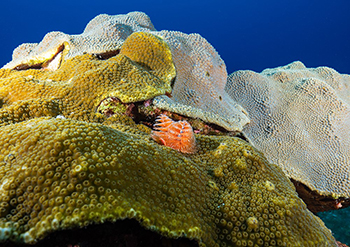-
Home
-
Data & Publications
-
Regional Portals
- About Regional Portals
- Florida
- Navassa Island
- Puerto Rico
- Flower Garden Banks
- U.S. Virgin Islands
- American Samoa
- Commonwealth of the Northern Mariana Islands
- Federated States of Micronesia
- Guam
- Main Hawaiian Islands
- Republic of the Marshall Islands
- Northwestern Hawaiian Islands
- Republic of Palau
- Pacific Remote Island Areas
-
CRCP Activities
- Glossary
Increasing coral calcification in Orbicella faveolata and Pseudodiploria strigosa at Flower Garden Banks, Gulf of Mexico

NOAA's Atlantic Oceanographic and Meteorological Laboratory used climate monitoring data and coral cores from the National Coral Reef Monitoring Program to show that two key coral species in Flower Garden Banks have increased calcification in the past 45 to 57 years. The data indicate that these corals have actually benefited from warming ocean temperatures over the last few decades. However, based on climate projections and the warming trend, the stimulation in growth due to warmer waters will eventually be impacted by worse and more frequent coral bleaching events. Given that the most severe bleaching event ever recorded at Flower Garden Banks occurred in 2016, the growth rates of these corals are likely reaching the threshold where further increases in ocean temperatures will no longer benefit coral growth.
Coral reefs are in decline worldwide and western Atlantic reefs have experienced the greatest losses in live coral cover of any region. The Flower Garden Banks in the Gulf of Mexico are high-latitude, deeper, remote reefs that are an outlier to this trend, as they have maintained coral cover equal to or greater than 50% since at least 1989.
Read the full study here: Increasing coral calcification in Orbicella faveolata and Pseudodiploria strigosa at Flower Garden Banks, Gulf of Mexico.


